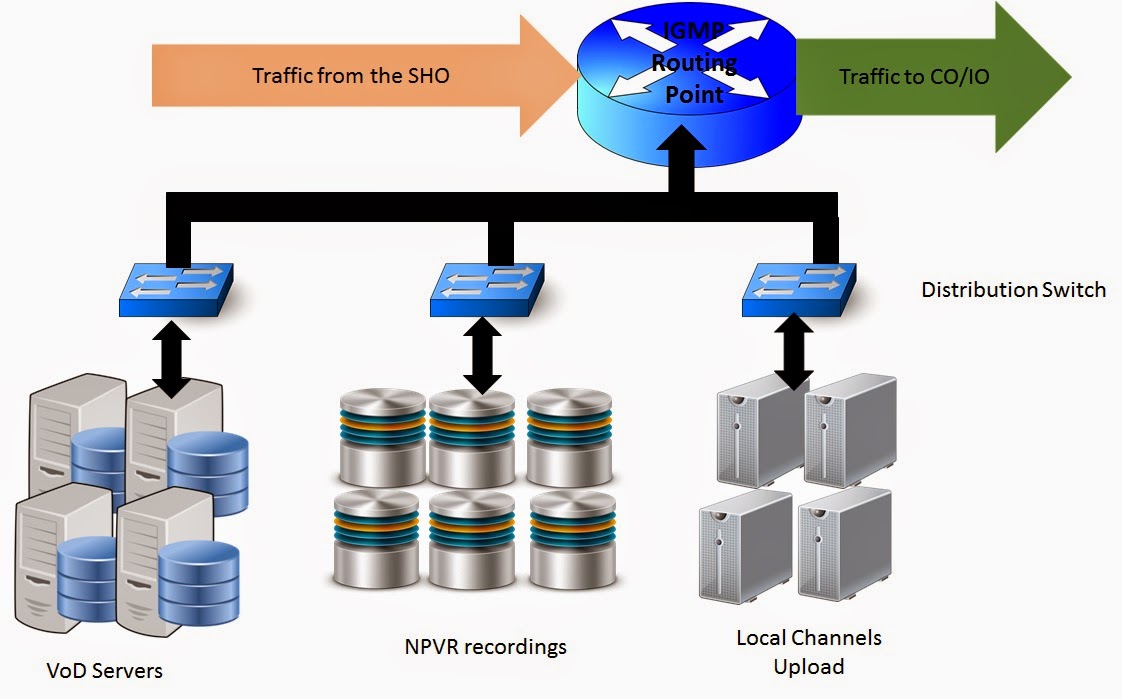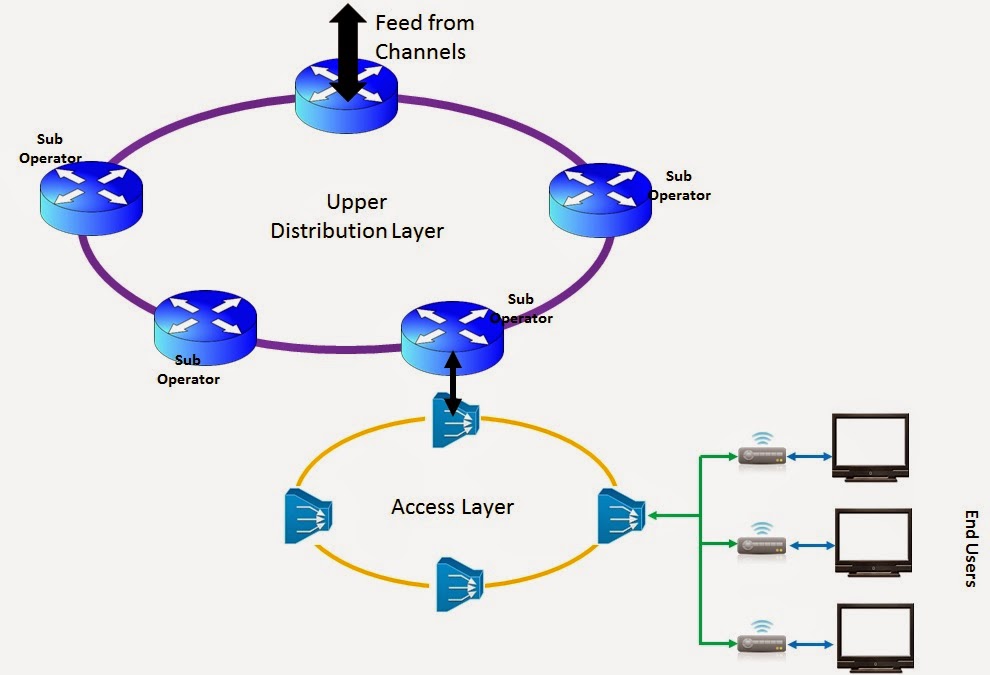My dear friends of transmission fraternity,

How are all of you? I hope all of you enjoyed Ganesh Chaturthi with lots of fun. I am very sure that the time ahead will bring lots of happiness and prosperity to all of your lives. Let us begin with where we had left before in our topic that related with IPTV and Multicast. Today we are going to talk about another component in the IPTV delivery system and that is the Video Hub Office or VHO. Let us recall the IPTV delivery model for our reference before we begin to study on the VHO. The Reference diagram of the IPTV deliver as was mentioned in the Blog before is there on the figure and we are going to actually see the VHO part that is in the intermediate location. We study now about the various parts of the VHO and how a VHO system is constituted.
1. Dimensional Positioning of the VHO:
As discussed in the previous BLOG a SHO is a place where you have major feeds of National Content and feeds of other channels coming in and aggregating. The SHO actually consists of a lot of encoders and transcoders that are converting the RF output of the signal to a provided multicast IP channel and is then transmitting this to the network. A VHO is actually a regional hub or a regional distribution system of this architecture. So as to say typically in a City there may be one VHO. If there is a large IPTV network rollout then the SHO will be one or two in the country for a Service provider. Say this can be in a location like Mumbai or Delhi or anywhere, close to the feeds. VHOs are typically in the regions like Bangalore may have one VHO. Many small cities will have one VHO and so on. The concept of VHO is similar to that of a Relay Center that used to be there in the DoorDarshan days.
2. Work of VHO:
The first and foremost work of a VHO is to efficiently distribute the traffic towards the customers, which are IO (Inter-mediate Offices) and CO (Cable Operators). VHO is actually acting as a intermediate route point for all the traffic. In order to understand more part of the work that the VHO does we need to actually see a high level diagram of the VHO unit. This diagram is a very basic diagram of the VHO, of course there are several other components and this goes well with the SHO also. Let us see the diagram over here.
 |
| Basic High Level Structure of the VHO |
As we can see that apart from only relaying the traffic that is being received from the SHO the VHO also has components related to VoD (Video on Demand), NPVR (Network Private Video Recorder) and Local channels. Let us dissect all these components one by one in this section.
2.1 VoD (Video on Demand):
IPTV has a very good option of Movie watching that can be taken on Demand. This means your movie at your time, with of course a kind of payment that you have to make in this entire thing. The set-top box of a normal IPTV service has a kind of a storage which is encrypted and the movie is downloaded over there for a particular time-frame for which the user makes the payment. Of course, more the time of storage that you would want more would be the charges. The VoD servers actually have a lot of movie content that may be regional and uploaded to the servers. There may also be a lot of popular movie content that may be kept at a local storage in the VoD servers. It is logical to think that the download would be much more effective if the content is placed near. In most of the cases the central content of VoD that may be in the SHO and based on the popularity in the region this may be actually downloaded to the local servers of the VHO. There can be a kind of popularity logic based on the demand of the content that may be actually served to the users.
It has to be understood that every content over here has a definite UNICAST IP and the transmission of a VoD content happens over a UNICAST BW. So let us understand now the QoS part. Suppose many users are actually downloading the VoD content to their Set Top Boxes so that there is a congestion in the network, what happens to the live transmission of the Multicast. Answer is very simple the Multicast is always kept at a higher priority, with a higher DSCP marking in the system. This is done to avoid even the slightest disturbance in Live TV services due to congestion in the VoD.
2.1.1: Optimizing the VoD delivery:
It can be now understood that if VoD is sacrificed at the cost of Multicast then what would actually be the value of such a service. Well, not to worry. Remember we talked about Multicast and then conditional multicast. As we can see that the router of the VHO is actually IGMP enabled and responds to the join and leave requests that actually come from the CO. Hence at every time not all the channels are transported to all the COs and there is BW free. This free BW and the reserve BW for VoD is used in case of a high demand of the content from VoD from seperate users.
But then what happens if the same content is demanded at more than one CO locations. In such a case the following can be done. The UNICAST VoD can be sent as a conditional Multicast to the COs using IGMP v3 (This is very seldom done) and the VoD stream can be given in a drop and continue fashion and BW can be optimized in a real way.
In the case of congestion in the VoD stream there can also be TCP window sizing that actually increases and decreases the window size as the resource availability is there and thus keeps the channel alive for the transport. This may delay the transfer of the file but keeps it reliable.
2.2 NPVR (Network Private Video Recorder):
NPVR can also be deployed in the CO layer for a better optimization but the practice is also to deploy it on the VHO. NPVR is a kind of a recording unit for the user that is in the VHO where there is an allocated space for him and then this content can be accessed as per his wish. NPVR enables the process of live recording and storage on the cloud. NPVR content can also be accessed by other users if there is a process of sharing possible. Let us take an example for this. Suppose you are watching a television series which you like very much and you keep it recorded, or you actually set a kind of time to record the television series at a particular time and store it in the NPVR of the IPTV cloud and then access it at your convenience. Also if there is a sharing enabled in your NPVR partition then this can be actually watched by other users that you assign as friends when they actually want it from your location. The storage can actually also be in your STB but then this does not enable the feature of sharing and multiple access of the content. A content that is stored in the NPVR can be accessed via the Television or actually by any other device. NPVR enables the multi-screening environment.
2.3 Local Channels:
Every region has its own local content publishers as well. Some of these publishers restrict the viewing only to that region as their popularity index is huge. Many of them can also provide the feed to other providers who actually broadcast this nationally. For example, if we are in Kerala, there will be several channels in Kerala that actually provide the local regional program and many of them are only local providers. These channels are actually hosted on the VHO of the IPTV Service provider. For these channels the Live feed and acquisition remains in the VHO station itself and then those are transmitted towards the customer.
So my dear friends, this is a high level view of the VHO. We will explore more in the SHO and the VHO areas as we go ahead. SHO and VHO both are really a full sea of equipments in the IPTV deployment, so there needs to be a lot of study don on the same. Only high level study is not enough.
Till then,
Take Care.....
Cheers.....
Kalyan

















